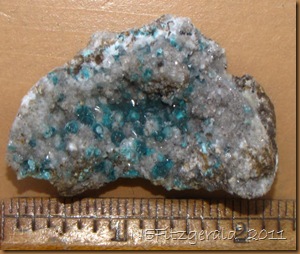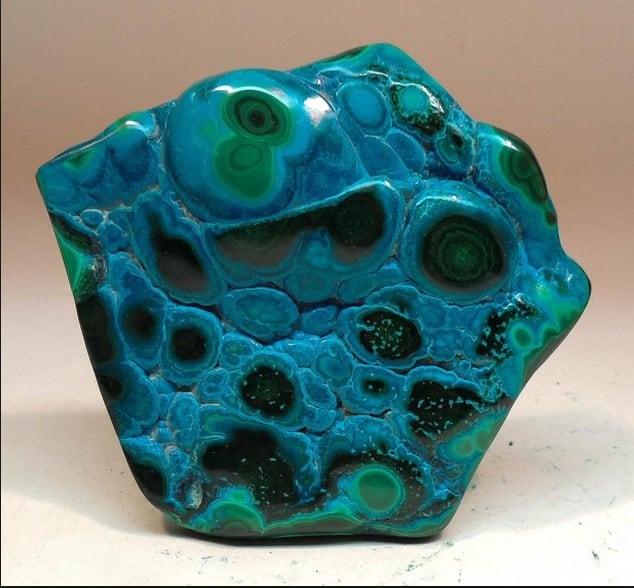For this third post in the WATCH FOR ROCKS mini-series on copper mineralization and skarn, I pose a thought-provoking fifth and final question:
Is there anyone left in the building?
No, wait. That was the fourth-and-a-half question. Here is the final fifth:
What are the relationships between copper (Cu) and other minerals such as chalcopyrite, cuprite, chrysocolla, bornite, malachite, and azurite, magnetite, and hematite, among others?
First, a word or two (I swear I am not making these up!) about hypogene and supergene processes…
Primary minerals are those that form by the combination of elements rather than by alteration of a mineral. Primary or hypogene minerals in a hydrothermal system can be extensively altered when exposed to oxygen in the near-surface environment.
 |
| Pyrite crystals – scale in inches |
Pyrite (FeS2), reacting with oxygenated groundwater, will form iron hydroxides and release the sulfur as sulfuric acid.
Chalcopyrite (CuFeS2), reacting with dissolved atmospheric oxygen and carbon dioxide, can produce cuprite (Cu2O) and siderite (FeCO3).
Chalcocite (Cu2S) commonly forms from the alteration of primary copper minerals that are attacked above the water table by oxygen.
The net result of these and related reactions is to oxidize the metals found in the sulfides to form oxides, hydroxides, carbonates, and sulfates. Because these reactions produce oxygen-bearing minerals at the expense of sulfides, the near surface zone (of the Earth, that is) is often referred to as the oxidized zone and the minerals produced are called supergene or secondary minerals.
Next is a simple listing of mineral names with each appropriate chemical formula. Listing these formulas serves to tie a nice neat bow on the whole copper mineralization concept. I hope you agree!
Common sulfide ores for copper include:
Bornite – Cu5FeS4, Copper Iron Sulfide
Chalcocite – Cu2S, Copper Sulfide
Chalcopyrite – CuFeS2, Copper Iron Sulfide – the most common ore.
Covellite – CuS, Copper Sulfide – an excellent ore of copper when available in economic amounts.
 |
| Aurichalcite – scale in inches |
Copper carbonates include:
Aurichalcite – (Zn, Cu)5(CO3)2(OH)6, Zinc Copper Carbonate Hydroxide – forms in the oxidation zones of zinc-copper deposits where it is deposited by circulating fluids of carbonate-rich solutions.
 |
| Azurite – scale in inches |
Azurite – Cu3(CO3)2(OH)2, Copper Carbonate Hydroxide – considered a minor ore of copper, mostly because it is found associated with other more valuable copper ores.
 |
| Outer Malachite with inner Chrysocolla |
Malachite – Cu2(CO3)(OH)2, Copper Carbonate Hydroxide
Copper oxides include:
Cuprite – Cu2O, Copper Oxide – Of all the copper ores except for native copper, cuprite gives the greatest yield of copper per molecule since there is only one oxygen atom to every two copper atoms.
Cuprite is found in the near-surface oxidized portion of copper-bearing hydrothermal sulfide deposits. It generally is produced by the alteration and oxidation of primary sulfide minerals such as chalcopyrite.
Copper silicates include:
 |
| Chrysocolla |
Chrysocolla – (Cu,Al)2H2Si2O5(OH)4· nH2O, Hydrous Copper Silicate – found in the oxidation zone of copper deposits; associated with azurite, malachite, and cuprite. It is an
important surface indicator pinpointing the
presence of disseminated copper deposits (porphyry copper ore). However, it is not an important copper ore.
 |
| Inner Chrysocolla with outer Malachite |
Iron oxides include:
Magnetite – Fe+2Fe+32O4 is very plentiful in skarn. In the metamorphic environment it is formed by reduction of hematite derived from the dissociation of sulfides and iron silicates.
Hematite – Fe2O3 forms under oxidizing conditions. It remains stable in a low-temperature contact metamorphic environment where it often replaces magnetite.
To Sum Up (yay!) ~~~
There are several possible sources of copper mineralization in skarns:
— It is uncertain whether the copper mineralization in the skarn comes from the quartz monzonite itself or whether in the act of the skarn formation the limestones are altered in such a way as to produce the mineralization.
— Fracturing of the crust enables hypogene or metasomatic mineralizing fluids to bring in copper and other metals from sources deeper in the earth. This could be an undiscovered porphyry deposit or some other unknown source.
— Additionally, the copper atoms may have been transported (from somewhere) by ionic diffusion to ultimately bind with the sulfur atoms.
Thinking of prospecting for Cu?
— Ore bodies will have a layer of chalcocite which corresponds to the present of a past water table level; this layer is called a “chalcocite blanket.” The chalcocite blanket is richer in copper than the upper oxidized portion of the ore body and usually richer than the primary unaltered ores below. The chalcocite blanket represents a real “gold mine” to the copper prospectors.
— Look for the chrysocolla.
Cocktail party tidbits:
— The Copper Age of Europe and the Middle East began around 4000 BC., a transition period as Neolithic stone tools gave way to the Bronze Age.
— Artifacts recovered from The Old Copper Complex of the western Great Lakes region have been carbon-dated at 1000-4000 BC. Ninety-nine percent pure copper was discovered in the Lake Superior basin in vein form and in the form of nuggets in glacial outwash gravel beds.
— Native copper (copper found in a chemically uncombined state) was mined for centuries and now is all but depleted as an economically viable ore. Other copper minerals are far more economical to mine and purify into metallic copper that is used for wiring, electrical components, pennies and other coins, tubing and many other applications.
 |






